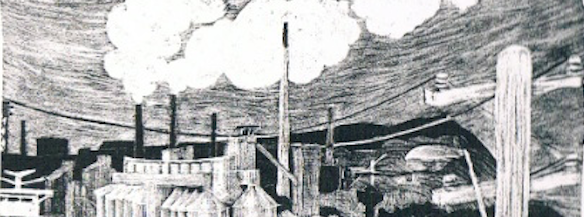
SHARON CALLAGHAN
Port, Poles and Wires: an exhibition and more …
What happens when a group of artists, filmmakers and storytellers creatively explore ideas about who controls shared public space and resources?
The answer: they produce words, images, film and sculpture that say it is well and truly time to think about how we create and manage public places and services. How we will protect and celebrate our common, public heritage.
The Port, Poles & Wires creative exploration unearths how official policing of public and private entities can shape citizens’ rights and can undermine our ideas of a fair go.
I have a faded linen tea towel purchased years ago at a housing rally that has simplistic hand drawn images of community life. A public park, public swimming pool, public library, public roads, transport and the bygone era public phone box. The punch line to this communal scene asks: ‘why welfare housing?’ There are accompanying exclamation marks where the exasperated maker of this screen-printed cloth demands we look at this picture and see the injustice.
How did the public get extracted from something as essential as housing?
The public or ‘common wealth’ carries with it ideas of fairness and supporting people when times are tough. Home ownership for most of us isn’t an investment but a base that provides sanctuary from work or life’s demands. It can serve as a safety net into older age. Public or social housing is another necessary approach to provide a secure roof that can match a family’s need at a particular time.
Keeping the public, the social, the communal and other useful models ever present in any picture of community life makes sense if we want to include everyone.
The principles that support fairness have a long association with publicly funded utilities and services. These values around our shared resources include the idea that they should be available to everyone, be subsidised for those living with hardship and protect fundamental rights, such as the right to work, live in safety, participate in public life.
If we continue to place profit making above human needs and rights, we are operating on the wrong model.
I truly dislike that we are all customers now. Every interaction viewed as a commercial transaction. We are told we are consumers of health, education, and community-support services thereby redefining our rights to have access to essential support.
Port, Poles & Wires is a project that questions the assumptions about what is private and public and who has access. Visit the exhibition and associated gatherings as you may have the answers.
Finally what can we learn from a faded tea towel on how the notion of public should work? The answer was there all along. Housing justice can be applied to all the essential services and entities, ports, poles and wires included. If the fairness test fails then we have to look at different models.
Sharon Callaghan
Port, Poles and Wires opens 6pm Friday 10 August 2018
Public housing films and panel 4pm Saturday 11 August 2018
Campaigns panel and materials 12 noon Saturday 18 August 2018
The black and white image at the top of each of the 'Port, Poles and Wires pages, of Port Kembla with poles and wires, is a detail of Kathryn Orton's lithograph, 'Greetings from Coniston'.

